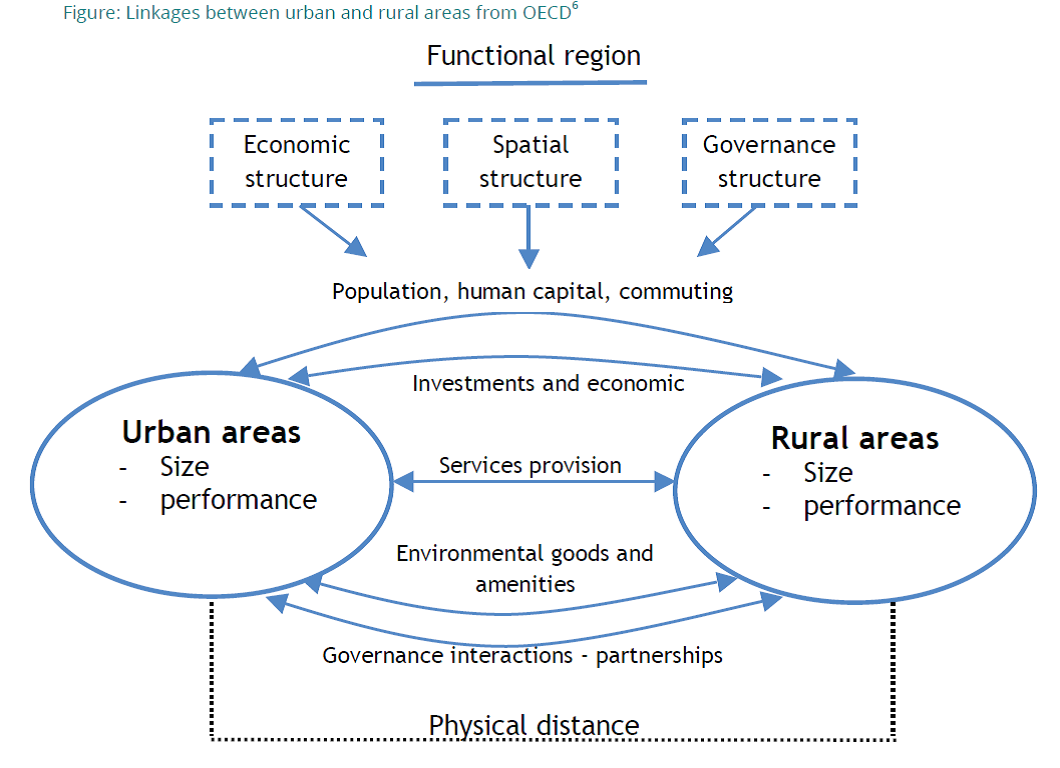RURAL ECONOMIC GROWTH IN INDIA AND THE EMERGING PATTERN OF RURAL TOWNS
Relevance:
Sociology: Paper II: Rural and Agrarian transformation in India:
G.S paper I: Society and social issues, Urbanization

Context:
The article analyses urbanization patterns and various aspects related to the increase in the number of census towns in India, particularly in the states of Gujarat and Rajasthan.

Structural changes in rural areas:
- Structural change portrays an increase in the gross domestic product (GDP) with an increase in income and employment in the non-agricultural sector, an increase in wages, and overall productivity. It also includes demographic changes including changes in rural-urban population, level of education, and strengthening of the communication sector which led to higher exposure to the outside world.
- The growth of urban centres which has engulfed surrounding rural areas has led to the economic transition of the associated rural areas.
- The increase in population in rural areas has put pressure on land and water resources. The mechanization of agriculture has released excess labourers, who were engaged in primary activities till now.
- Shift to non-farm activities is the major factor behind the socio-economic transformation of rural areas in recent decades. According to NSSO 2014, male employment in agriculture has declined from 67% in 2004–05 to 59% in 2011–12. In the corresponding period, female employment has declined from 83% to 75%. The decline in the absolute numbers of agricultural workers was accompanied by an increase in non-farm jobs, and as a result, rural wage rates increased after 2006. Since 2004-05, the construction sector has generated most jobs in the non-farm sector.
- The growth of non-farm employment has led to an increase in the population of villages. They have been transformed into small towns and service centres.
- These small and census towns are accelerating urban growth. Their percentage of the total population of urban areas has increased from 7% to 14% between 2001 and 2011. This was considered as largely an outcome of the positive relationship between economic growth and urbanization.
Urbanization in India:
- There are three factors that determine urban growth: natural births and deaths, net migration and immigration, and the reclassification of rural land and extension of city boundaries.
- Net rural–urban migration in India is lesser as compared to other countries, leading to slower urbanization.
- A lower degree of urbanization is also due to the very conservative urban definition. An area is an urban area if it has more than 5,000 population, more than 75% of male non-agricultural workforce, and a population density of greater than 400 persons per sq km. An area that does not fulfill the above criteria is classified as a rural area, however, in other countries, they would have been classified as urban areas.
- Differences in growth rates of rural and urban areas have also slowed the pace of urbanization.
- States having higher per capita income have a higher urbanization rate. For example, Maharashtra, Kerala, Tamil Nadu, and Gujarat which are relatively rich have recorded urbanization rates above 40%. In poorer states such as Bihar and Odisha, urbanization is less than 20%.
- In analyzing urban growth, another factor to be considered is whether the urban population is concentrated in larger towns or whether it is evenly spread with an increase in the number of small/medium towns. The latter is indicative of a more uniform process of economic development.
- According to the 2011 census, census towns that are considered as “missing or unacknowledged urban settlements” have increased to 3,894 from 1,362 in 2001. In contrast, statutory towns rose marginally from 3,798 to 4,041.
- Due to economic growth, many villages have gained the status of a town and this has led to an increase in the numbers of census towns. States are reluctant to grant statutory status to the census towns because if they do so then they will have to provide funds for urban infrastructure.
- Even residents of census towns want to remain rural in order to benefit from rural development schemes and escape from high tax rates.
- With census towns being governed as rural areas, the old notion of the rural-urban divide has given rise to a rural–urban gradient, with a large number of “rurban” or peri-urban centres.
- In Gujarat and Rajasthan, between 2001 and 2011, census towns have increased from 74 and 38 to 153 and 112 respectively.

Rural Economic Transformation
- Rural economic transformation has led to an increase in census towns. The economy in rural areas is undergoing diversification, with an increasing number of people being employed in non-farm activities, like trade, hospitality sector, transport/communications, manufacturing, and other services with the construction sector being the largest employer.
- In 2013, of the total share of agricultural households in the total rural households of the country, almost 22% of these agricultural households reported wage/salaried employment as their principal source of income.
- Ownership of land is the chief determinant of income from cultivation for agricultural households. Between 2004-05 and 2010-11, the operational landholding has declined from 1.23 hectares (ha) to 1.16 ha.
- The increasing dominance of non-farm income sources is also corroborated with the changes in rural employment and income levels.
- The economic base in rural areas is changing. There is a shift from crop production to manufacturing or value-added activities. The working population is shifting from villages to small towns. This has led to the emergence of a rural-urban continuum.

Decomposition of Urban Growth:
- Small towns often act as intermediaries between rural and urban sectors and it is evident from many cases that these towns have developed over time and become urban centres because of the agglomeration economies.
- These towns have numerous features such as easy access to capital, labour and market, technological spillovers, which enhance opportunities in the non-farm sector and spread of urban growth in the hinterland.
- These features enhance the rural-urban and inter-sectoral linkages and also improve market-based agricultural activities. These small towns have been acting as intermediaries for the rural economy because of improvement in transportation facilities and communication channels.
- This promotes the integration of the rural economy with informal, non-job creation and self-employment.
- One of the impacts of this positive externality can be seen in the form of limiting rural-urban migration and eradication of unsustainable growth in the overburdened cities.
- The composition of urban growth becomes very important for any policy discourse on urbanization.
- Many economists define “peri-urban areas” as the amalgamation of rural and urban activities. These areas are interlinked with urban economies and they also connect the rural areas with the cities. Hence, they undergo constant transformation and function as multifunctional territory.
- The increase in the number of census towns within the proximity of statutory towns can be characterized as “peri-urban growth”. There is also a concept of in-situ growth, which leads to the development of small villages into towns. In general, it is assumed that the rural-urban migration or commute is essential for urbanization but, in situ growth leads to the transformation of rural areas into urban or quasi-urban areas with mere geographical relocation of the residents.
- This type of transformation even far away from the metropolitan areas is often known as “subaltern urbanization”.
- China is an example of this type of urbanization where transformation occurs through the physical and functional changes by developing townships and village enterprises.
- There are various studies available that support the view that small towns play an important role in developing the rural as well as urban economies. However, forces such as infrastructure, entrepreneurial activity, and growth of market-based agriculture are crucial for the development of urban economies, supralocal capital and labour flows also contribute to the transformation process.
Implied Urbanisation:
- A large number of urban settlements are administered as rural. Several villages are on the verge of developing urban characteristics.
- If workforce criteria to define urban settlements are relaxed then the number of urban settlements will increase.
- Development challenges related to unrecognized urbanization can be ascertained by looking at the villages which are on the verge of urbanization.
- The transformation of villages into towns is an ongoing process, even though their statutory status remains unclear.
- With the relaxation of population and workforce criteria, the urbanization level in Gujarat could be anywhere between 42% and 47%.
- A large number of villages in Rajasthan are on the way to getting urban status. The urban population of Rajasthan can increase from the present 25% to 45%.
Urbanization pattern in Gujarat and Rajasthan:
- In Gujarat, proximity to big cities, better transportation facilities from rural to urban areas have led to a rise in the numbers of census towns.
- The nature of the rural non-farm sector depends on its location. Villages in the vicinity of urban centres belonging to the manufacturing/transportation corridor (DMIC) have grown due to the migration of people to these urban centres.
- These villages provide residential space to migrants who cannot afford housing in urban areas.
- Acquisition of agricultural land for industrial estates, administrative centres, ports, etc. has aided the transformation of villages.
- With agriculture giving way to non-farm activities, and governments favouring industrial growth in backward regions the villages underwent a shift in the economic base and acquired an urban character. The absence of irrigation facilities, adverse agro-climatic conditions, and falling agricultural productivity have led to an increase in non-farm activities and led to a rise in census towns.
- On the other hand, higher agricultural productivity has also economic development and economic diversification. This together with an increase in literacy level has narrowed the rural-urban fertility differential. However, the overall effect of agricultural prosperity is often indeterminate.
- Many new urban settlements are facing environmental issues related to land, air, and water pollution. Giving them statutory status will be helpful in strengthening urban amenities in these areas.
- In Rajasthan, a large number of villages acquired town status in the 2011 census despite the initial lower urbanization level. Due to underdeveloped agriculture, there is a lack of opportunities for gainful employment. As a result, the rural population took non-farm jobs, mostly in construction activities, services, trade, etc. in larger villages. This is a major reason for the spread of census towns in Rajasthan. The dependence of people on robust sources of income such as business has also pulled them out of poverty.
- Failure of the states to implement provisions of the Mahatma Gandhi National Rural Employment Guarantee Act (MGNREGA) to arrest distress migration has also added to the migration of people from villages to take up non-farm jobs. It was aided by lucrative opportunities presented by the boom in the construction sector.
Conclusion:
- The absence of village/town development plans has led to haphazard growth of the towns across the country. Inadequate urban amenities such as street lights, fire fighting services, and bus routes have worsened the living conditions. A regionally focused strategy is required for planned urbanization.

